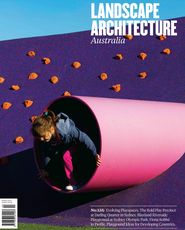In the February 2012 edition of Landscape Architecture Australia, Joshua Zeunert 1 (read the article here) challenged “the biodiversity dogma” in a curious article pushing for community horticulture. This was a somewhat straw man argument. Any notion that the reinstatement of biodiversity is a blanket approach to landscape design practice is false because the role of endemics and exotics and “what to plant where?” is much debated in both ecological science and design.
Zeunert appeared to set up simplistic oppositions between local biodiversity and urban food production, between large-scale agricultural production and the rest, between Indigenous culture and European, and between the past and our current and future needs. He based his discussion on the idea that habitat creation with endemic plants is linked to both destroyed landscapes and dead Indigenous cultural practices. First, the inferred concept of replanting a pre-1750 vegetation for Australia is outdated. Rather, we have a much greater understanding of global biodiversity, the flux in species compositions over time, the importance of exotics as a threat to local and regional biodiversity, 2 and the ethical dimensions of biodiversity. Second, the notion that to plant endemic species ties us to “resurrecting and living by the same cultural practices that enabled it” is a strange assertion, given the comparatively recent tenure of Aboriginal culture (sixty thousand years) on an ancient landscape and its flora. Banksias, for example, have a lineage of approximately 54 Ma (million years ago), with fire responses in place by 40 Ma, 3 and great speciation from 25 Ma. 4 Third, many Indigenous cultural practices are alive and increasingly understood as better management of country due to the depth of their perceptions and their engagement with complexity, event fluxes and spatial variability.
As Australian designers, it is important to consider where information is coming from. Most ecological information and landscape architectural design and theory comes from the young landscapes of Europe and North America, which experienced significant ice cover in the last glacial periods. We did not. Our scant ice cover led to significant differences between the Australian continent and the northern hemisphere. In Australia we maintained our long legacy of intense speciation, while the northern hemisphere experienced two phenomena. First, Europe and much of Asia north of the major mountains lost significant flora due to the west–east alignment of mountain barriers; North America lost fewer as the mountain barriers run north–south and escape from ice was possible. Second, with the return of warmer conditions, speedy colonizers moved into these vast areas, thus large areas of the northern hemisphere – where most of our ecology and design theory comes from – was colonized by few species occupying vast tracts, 5 such as larch into Siberia and birch into Europe. This is the opposite of Australia, which is noted for intense speciation within small areas. For example, there is more genetic diversity in kangaroo paws in a small part of Kings Park in Perth than in all the spruce in North America. We have a unique position which points to planting richly for design as a strong link to our environmental history.
While often confused as such, biological diversity is not just about species numbers. It includes genetic complexity and biological processes. Local flora supports these more hidden aspects of biodiversity. Some local fauna will always be able to adapt to exotic species but many little things, perhaps mostly unseen to us, will not. Such things have flow-on effects in our ecosystems.
Responses to changing climate will be paramount to our understanding of what to plant where. For example, in the next one hundred years, southern Australia is expected to become hotter and drier, with Melbourne having a climate more akin to Mildura’s current climate. Species assemblages will break down, as in the last Ice Age. This will create ecosystems previously unknown as plant ranges change, or attempt to change across our built form. We will be very much in the world of novel ecosystems and “third nature” of Giles Clement, as well as working for ecosystem services towards carbon sequestration.
With burgeoning knowledge of past climates, genetics and ideas of resilience in the light of global warming, we now have more information as designers to make informed planting choices as to the most appropriate interventions, even in urban landscapes. “Urban agriculture” is just one potential of a site; this is really community horticulture, while agriculture is engaged with large-scale population-level food production (i.e. we can’t grow enough wheat in Sydney’s suburbs to make the city’s bread). Farmers in Australia, now also with more knowledge about country than their predecessors, are working to restore landscapes with a view to assisting country to find old rhythms while being resilient to our largely uncertain futures; with good ecological knowledge designers can assist.
Ecological education for landscape architects is coming to a crossroads in Australia. We need to move away from the fuzzy ecological knowledge enslaved by the thinking in oppositions typical in landscape architecture and move to sharper and more specific knowledge of complex ecologies and design solutions. It is important through education to position ecological theory and knowledge as inseparable and fundamental to landscape architectural theory and practice. We may then see a new generation of graduates start to emerge with a deeper understanding of ecological concepts and theories, and thus there is a greater capacity for these to act as scaffolding to inform design. I hope then that practitioners will see a new breed of landscape architects.
1. Joshua Zeunert, “Beyond Biodiversity: challenging the biodiversity dogma,” Landscape Architecture Australia no 133, Feb 2012, 13–14.
2. F. Stuart Chapin III et al., “Consequences of changing biodiversity,” Nature, vol 405, 2010, 234–242.
3. Tianhua He, Byron Lamont and Katherine Downes, “Banksia born to burn,” New Phytologist, vol 191, 2011, 184–196.
4. Mike Crisp, Lyn Cook and Dorothy Steane, “Radiation of the Australian flora: what can comparisons of molecular phylogenies across multiple taxa tell us about the evolution of diversity in present-day communities?” Philosophical Transactions of the Royal Society, B 2 359, 2004, 1551–1571 [doi: 10.1098/rstb.2004.1528].
5. Hans Peter Comes and Joachim W. Kadereit, “The effect of Quaternary climatic changes on plant distribution and evolution,” Trends in Plant Science, vol 3 issue 11, 1998, 432–438.
Source

Discussion
Published online: 1 Aug 2012
Words:
Margaret Grose
Issue
Landscape Architecture Australia, August 2012














